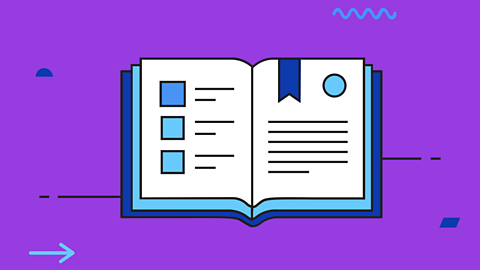This page provides tips to help you approach the English language exam. These insights will help you to develop the key reading and writing skills needed to answer a variety of question types.
The exam assesses your ability to understand, analyse and compare texts, as well as to write clearly, persuasively and creatively. These tips will help you to develop essential exam strategies such as identifying key information, analysing language and structure and comparing texts.
Remember, the questions on the exam paper are not released until the day of the exam. The examples on this page are a guide to the topics and question structures that could be on the paper.
Top tips: Past exam papers
1. Identifying and interpreting information (Paper 1)
Past paper trend: The first question on Paper 1 typically assesses Assessment Objective 1, which focuses on your ability to 'identify and interpret explicit and implicit information'.
Exam tip: To get all four marks for this question you will need to locate four accurate quotes and either copy them from the text or summarise them into your own words. Make sure that any quotes are short and only write down the parts of the quote that relate to the answer.
Strategy:
Read the question carefully and highlight the keywords that indicate what to look for.
Highlight the relevant lines in the text to ensure you pick the right quotes.
If you have more answers than marks choose the most obvious and relevant ones and write them clearly on the exam paper.
2. Locating quotes
Always read the questions carefully before starting to write. Pay attention to what the question is asking and select your evidence accordingly. This will help you locate quotes that directly answer the questions.
Exam tip: Before reading the sources skim through the questions to understand what kind of information you'll need to find.
Strategy:
Highlight the key words in the question after reading the source: Once you’ve read the source go back to the question and highlight the key task. For example:
"How does the writer use language to interest and inform the reader?"
Focus on key phrases like 'use language, 'to interest' and 'to inform'.
Analyse the text with purpose. As you re-read the text highlight anything you think the writer has used intentionally to inform or interest the reader.
Organise your response. Set up a simple color-coding system. Yellow: highlight sections used to inform. Green: highlight sections used to interest. This system helps you clearly see and write about how the writer is informing and how the writer is interesting the reader.
Use colour coding across the exam. Assign a different highlighter colour for each question throughout the paper. When re-reading the text mark evidence for each question in its corresponding colour. This makes it easier to organise your ideas and quickly locate relevant quotes when writing your answers. You can use highlighters on the question booklet to mark important information, but not on the answer booklet. In your answers underline or annotate relevant details instead.
3. Analysing language and structural techniques
Past paper trend: There will be questions that require you to identify, analyse and explain the effects of language and structure.
Exam tip: Make sure you understand the difference between language techniques and structural techniques.
Language techniques focus on the specific words and phrases used by the writer, such as metaphors, similes, alliteration or personification. Your task is to explain why the writer has chosen these techniques and the impact they create.
Structural techniques refer to the way text is organised and presented. These include sentence length, paragraphing, shifts in focus, repetition and contrast. When analysing structure consider why the writer has chosen these techniques and how they shape meaning or impact the reader. For example, a one-line paragraph might be used to emphasise a key idea, creating a dramatic or suspenseful effect. Always think about the writer’s purpose and the effect on the audience.
Strategy: Revise common language and structural techniques so that you can easily spot them in the unseen text and understand their effect. The questions specifically ask about language or structure so make sure that you use the correct techniques when writing about either.
4. Comparing texts
Past paper trend: You will be assessed on your ability to compare texts in Paper 2 where you will have two sources.
Exam tip: You're usually asked you to summarise the similarities or the differences between the texts in relation to a theme. This response is a summary of what you read in both texts. To tackle it you need to highlight the difference or similarities as you read the texts and then aim to write about them in a comparative way.
Strategy: A good way to answer this is to use comparing statements with comparative connectives. This format could help you:
In source A, the writer states “add quote.” This suggests…
In source B, the writer states “add quote.” This suggests…
This is different/similar because…
The paper usually states that you should give three similarities or differences. You can use this format three times to help you.
5. Writing tasks
Past paper trend: Half of the marks in Paper 1 and Paper 2 are awarded for writing.
Exam tip: In the writing sections of the paper (Section B) there are 40 marks awarded to the written piece. This accounts for 50% of the total marks in each paper so it's essential to manage your time effectively to complete this section.
Each written piece is worth 40 marks, split into:
- 24 marks for content and organisation - This assesses your ideas, structure, clarity and engagement with the audience.
- 16 marks for technical accuracy - This covers spelling, punctuation, grammar and sentence structure.
Strategy:
Choose only one task: There will always be two tasks and you should choose the one that you think you can write most about. Read the task carefully and prepare it by looking at the format, the intended audience and the purpose. Use FAP to help you.
F – Format – what kind of text do you need to write and what are the conventions of that text?
A – Audience – Who is the intended audience and how does this impact on your style and tone?
P – Purpose – what are you writing? What are you writing for? How does this impact on your content and the style of what you write?
Manage your time wisely: Ensure you allocate enough time to complete Section B.
Use the sources effectively: The reading section often links to the writing task, so use the sources for ideas, quotes, or inspiration. If you're unsure how to spell a word check the source text to find its accurate spelling.
Focus on spelling, punctuation and grammar (16 marks): Check your sentences, punctuation and paragraphs carefully. Ensure every sentence starts with a capital letter and ends with the correct punctuation. Go back through your writing to correct any mistakes.
Plan for content and organisation (24 marks): To achieve top marks your writing must demonstrate 'compelling and convincing communication'. To help achieve this:
Plan your writing before starting - outline your main points and structure.
Decide on the vocabulary, punctuation and techniques you will use.
Jot down key vocabulary, phrases and punctuation ideas during your plan. This helps you stay organised and ensures you don’t forget important elements.
Revise English language
Explore more English language resources with the full range of help from Bitesize.
Revision podcasts - English literature
Supercharge your GCSE English literature revision by listening to these podcasts on set texts.

Support - exams and revision
Exams can be stressful, but don't worry: we've got you. Check out our handy tips and advice for keeping on top of your studies and revision.

Edexcel GCSE English Language
Bitesize's full range of revision materials for English Language.

Podcasts - Study support
Study smarter and take care of your wellbeing with two Bitesize experts.
